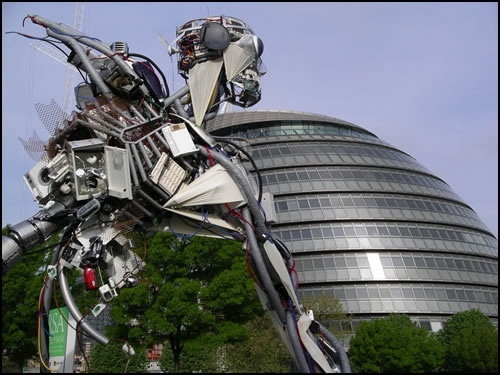Real-life Iron Giant invades IT recycling debate

At just over seven metres tall with computer mice for teeth, a washing machine for a spine, and a head made up of PC monitors, the WEEE Man (pictured below) is not your usual environmental campaigner but he's certainly attracting attention.
Unveiled on Friday at a special event at the GLA headquarters on south bank of the Thames, the statue is designed to publicise the European directive on Waste Electrical and Electronic Equipment (WEEE) which aims to make vendors and end-users of technology more responsible for its eventual disposal.
WEEE Man is made up of around 3.3 tonnes of waste electrical equipment — equivalent to the average amount a consumer is expected to get through in their lifetime. The UK population is estimated to generate around one million tonnes of household waste tech every year.
The statue was commissioned by the UK's Royal Society for encouragement of Arts, Manufacturers and Commerce (RSA) in association with printing company Canon. RSA Chairman Paul Judge said that it was vital that manufacturers and consumers of IT equipment begin to take their environmental responsibilities more seriously. "Every year the UK disposes of a million tonnes of IT waste and 90 percent ends up in landfill. The UK is running out of landfill sites. Both the public and business need to realise the huge environmental damage our current consumption of WEEE causes," he said.
Judge claimed that consumers and manufactures need to start thinking in sustainable and energy conservation terms when it comes to technology. "Around 85 percent of British households have a microwave but during its lifetime the average microwave uses more electricity keeping its light on that to actually cook food," he said.
The WEEE directive is intended to make manufacturers and consumers of technology more responsible for its disposal. It was due to be incorporated in UK law in August this year but last month the DTI revealed that most elements of it will not be written into the statute books till January 2006.
Analyst group Gartner claims vendor recycling costs will ultimately be passed on to end-user organisations. In a recent research note, EU's New Recycling Rules could Drive-Up European PC Prices, the analyst group estimated that legal changes could add $60 (£33) to the price of PCs in Europe by 2005.
"From 2004, budgets should incorporate the costs of equipment disposal. From 2005, budgets should be allocated for a separate recycling fee. This will most likely be included in the purchase price of new PCs," said Gartner.
WEEE is the fastest growing waste stream in the European Union and represents a contribution of 14kg per European citizen, or 6.5 million tonnes in total a year. The amount of WEEE in the EU is growing at up to 8 percent per year and the content of hazardous components is of major concern according to the RSA.
In a recent interview with ZDNet UK, Friends of the Earth senior waste campaigner Claire Wilton said that highlighting the safe disposal of waste IT is important but more emphasis needs to be put on environmentally friendly product design
"The thing they [electronics manufacturers] are successfully managing to weasel out of — because the law is not strong enough on this — is eco-design. The government has set up a committee to look at how companies can build eco-design into their products but at the moment it's voluntary and we would prefer to see regulation," said Wilton.
Eco-design features include creating products that are more energy efficient, use fewer raw materials and are designed so parts can be recycled easily at the end of their useful life.
The WEEE Man is currently squatting outside City Hall, adjacent to Tower Bridge, but will be relocated this summer to the Eden Project, in Cornwall.
